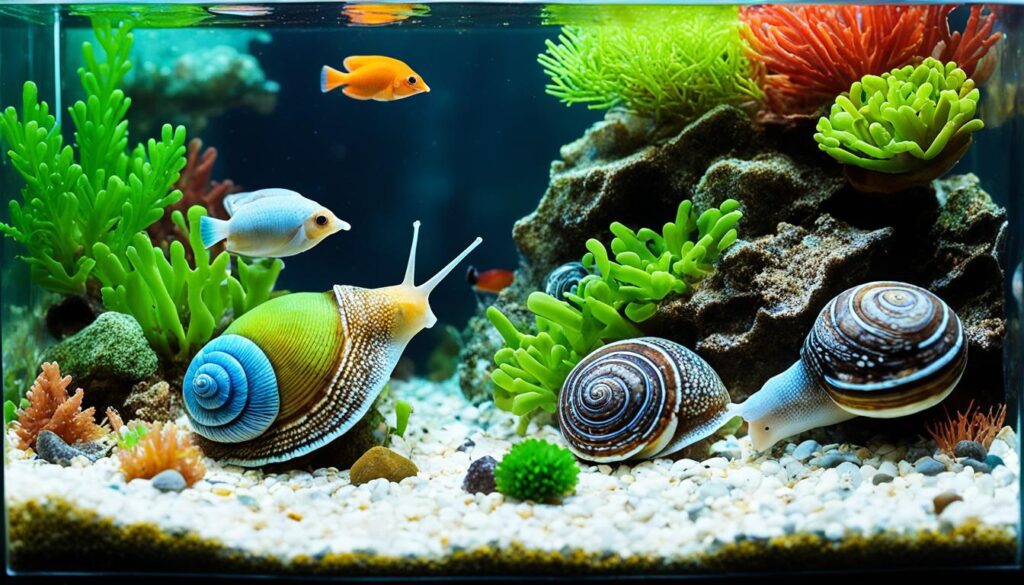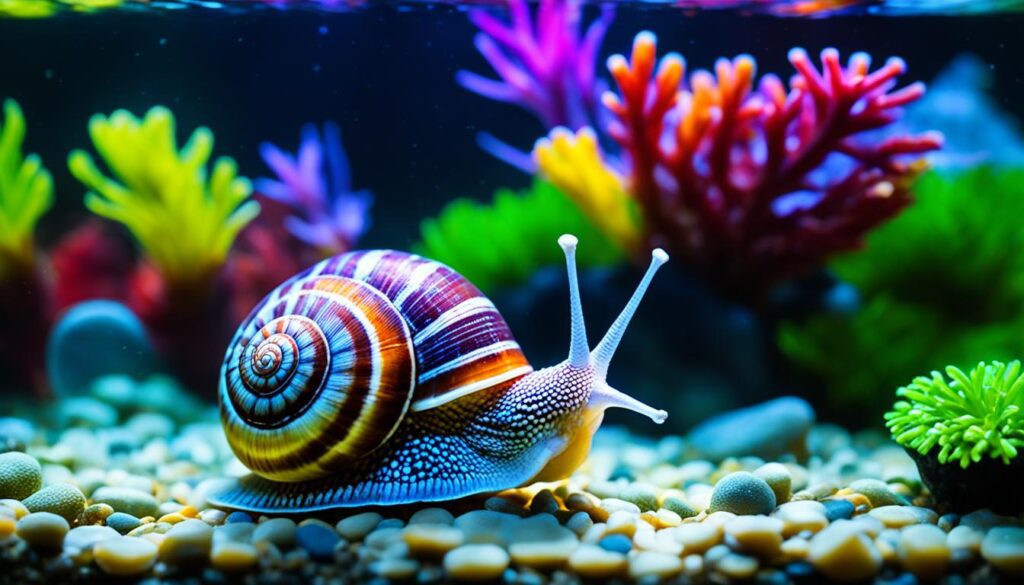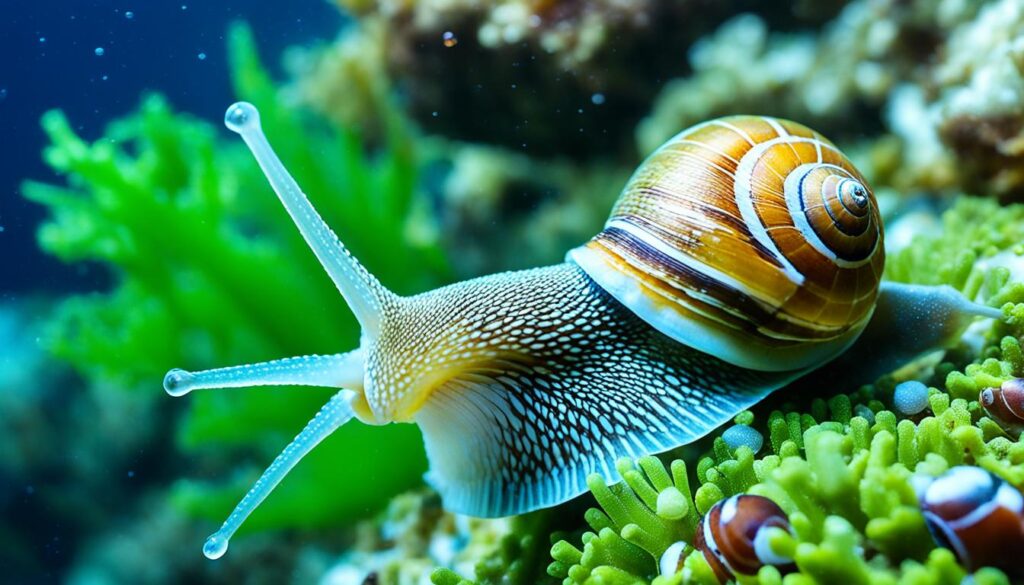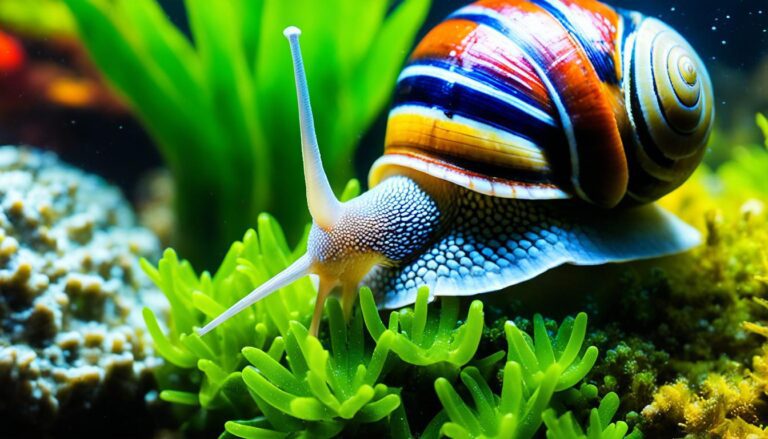I love talking about the beauty of marine life, especially when it comes to caring for Margarita Snails. These elegant creatures, scientifically known as Margarites pupillus, really stand out among aquarium snails. Not only are they fantastic at keeping algae in check, but they also get along great with other marine inhabitants.
My goal is to help you keep your Margarita Snails healthy and thriving. Caring for them is both simple and rewarding. These snails are excellent tank cleaners and make wonderful additions to any marine ecosystem.
Proper care is key to their well-being, which includes understanding their diet and maintaining the right water conditions. I’ve found that Margarita Snails do best when their environment closely resembles their natural habitat. Whether you’re a seasoned aquarist or just starting out, this guide will walk you through everything you need to know about keeping these snails happy.
A healthy tank is a beautiful one, and Margarita Snails play a big role in that. Let’s create an environment where these little cleaners not only live but truly flourish, enhancing the beauty of our underwater worlds.
Margarita Snail (Margarites pupillus) Species Profile

As a passionate aquarist, I’m excited to dive into the unique world of the Margarita Snail, a true gem among reef aquarium snails. These little guys are not only great at devouring algae but also make excellent companions for coral-friendly invertebrates, making them an essential addition to my tank.
The Distinctive Features of Margarita Snails
What first caught my attention was their striking brown, turban-shaped shell. It really makes them stand out from the crowd. Margarita Snails grow up to about 1 inch, making them both visible and incredibly useful. Their relentless drive to control algae is unmatched, which keeps the tank looking pristine.
Coraline vs Non-Coraline Varieties
The Coraline Margarita Snail is truly a sight to behold, with a shell beautifully covered in bright Coraline Algae. This not only adds a splash of color to your tank but also helps promote coral health. On the other hand, the non-Coraline varieties may have a simpler appearance, but they’re just as effective when it comes to algae control. Both types are top-notch when it comes to keeping your aquarium clean.
To understand these creatures better, I’ve put together a table of their preferred environments:
Feature |
Description |
Benefits |
|---|---|---|
Size |
Up to 1 inch |
Ideal for most tanks |
Shell Type |
Coraline and Non-Coraline |
Brings beauty and functionality |
Environment |
Cooler waters |
Good for snail well-being |
Diet |
Algae |
Keeps tanks clean and thriving |
Tank Compatibility |
Peaceful with most reef occupants |
Makes for a peaceful tank |
From my experience, Margarita Snails are great for both looks and health of the tank. They’re a wise choice for any aquarist looking to improve their setup.
Margarita Snail Size and Growth Expectations

Aquarists need to know how Margarita snails (Margarites pupillus) grow. This includes the standard and Coraline types. The size they reach depends on several factors.
Size Range and Growth Factors
Margarita snails grow to a shell diameter of 1/2 to 1 inch when mature. They need the right diet and environment to grow. Algae are crucial for their diet.
Water quality affects their growth too. Proper pH, temperature, and alkalinity are key. These conditions help create the best place for them to develop.
Comparing Adult Sizes: Margarita Snail and Coraline Margarita Snail
The Margarita snail and Coraline version mostly grow to 1 inch. Despite their environment, they reach similar sizes. Regularly check their living conditions to help them grow.
Characteristic |
Margarita Snail |
Coraline Margarita Snail |
|---|---|---|
Maximum Size |
1 inch |
1 inch |
Ideal Water Temperature |
72-78°F |
72-78°F |
Algae Availability |
High |
High |
pH Level |
8.1-8.4 |
8.1-8.4 |
The growth of Margarita snails largely depends on their habitat. Good tank conditions support their health and growth. This helps them reach or even exceed their expected size.
Margarita Snail Tank Requirements

It’s vital to create the right Margarita snail habitat. These snails need special saltwater aquarium conditions like their home along the Pacific coast. Setting up the marine tank properly is key for their health.
- A tank of at least 10 gallons is best for them to move and eat freely.
- The water should have a pH of 8.1 to 8.4 and salinity of 1.023 to 1.025. Temperatures must stay between 72 to 78°F.
- Checking and adjusting the water quality often is important. It keeps the snails from getting stressed.
Having the right tank setup helps Margarita snails stay healthy. It also makes them great tank cleaners since they eat algae. Here’s a guide for setting up your tank for Margarita snails:
Parameter |
Value |
|---|---|
Minimum tank size |
10 gallons |
Temperature |
72 to 78°F |
pH Level |
8.1 – 8.4 |
Salinity |
1.023 – 1.025 |
Acclimation time |
2+ hours |
Herbivorous diet |
Phytoplankton and Algae |
Keeping saltwater aquarium conditions stable boosts Margarita snails’ health and life. This makes your marine tank setup work. Let’s give our underwater friends a happy and healthy home!
The Lifespan of a Margarita Snail and Influencing Factors

For those who love marine life, knowing about Margarita snail longevity is key. These marine invertebrates’ lives are often talked about but not well understood. We’ll look at ways to keep them healthy and living longer.
Calculating the Average Lifespan
Margarita snails usually live between 1 to 2 years. With great care, they can live longer. They do well in settings like their natural home, and this helps them live longer. Keeping the tank clean and feeding them lots of algae are big helps.
Environmental Impact on Snail Longevity
Creating the right home for Margarita snails is vital for their lifespan. The tank’s temperature and how salty the water is are very important. Here are the best conditions for these snails and tips for taking care of marine snails in general.
Parameter |
Values/Description |
|---|---|
Tank Temperature |
Roughly 68 degrees Fahrenheit |
Tank Size |
40 gallon breeder |
Salinity Levels |
1.025-1.026 |
Light Cycle |
9 hours of high-intensity light, 9 hours no light, 3 hours low intensity |
Livestock |
Includes species like Sea lettuce, Daggerblade grass shrimp, Catalina Goby, Kamohara Blenny |
Additional Observations |
Margarita Snails consume most types of algae except blue-green algae, crucial in marine snail care. |
It’s important to choose the right tank mates and watch the water closely. This helps your Margarita snails live longer. Keep an eye on the tank and make changes as needed to give them the best life.
By following these tips carefully, your tank will be a great home for these peaceful snails. Not only will the snails be healthier, but your tank’s ecosystem will be too.
Diet and Feeding Practices for a Healthy Margarita Snail

It’s crucial to feed Margarita snails well to keep them healthy. They do best on an algae-based diet. This is because they naturally eat different kinds of algae in the wild.
Algae: The Primary Dietary Need
Margarita snails need a diet full of algae. This makes them great for keeping algae in tanks under control. They need constant access to algae. Types important for their diet include diatoms and hair algae, which are essential for invertebrate nutrition.
Supplementing Algae in Low-Growth Tanks
In tanks where algae don’t grow well, adding more nutrients is key. You can use dried seaweed or algae-based pellets. Fix these to algae clips or around things like rocks or shells. This not only feeds them but also keeps them busy.
These feeding tips help Margarita snails get the nutrients they need. They also keep the tank’s ecosystem balanced. Here is a list of suitable snails for different tanks:
Snail Type |
Recommended Density |
Notes |
|---|---|---|
Nassarius Snail |
1 per 5 gallons |
Excellent for cleanup, not algae eaters. |
Astraea Snail |
No specific density guideline |
Consumes green and brown film algae. Can’t right itself if overturned. |
Cerith Snail |
No specific density guideline |
Consumes film algae and diatoms, beneficial for substrate aeration. |
No specific density guideline |
Feeds on a variety of algae types, particularly diatoms. |
|
Bumblebee Snail |
Avoid in herbivorous snail tanks |
Predatory, not suitable for tanks prioritizing algae eaters. |
With proper feeding plans and a keen understanding of what Margarita snails prefer to eat, they will not just live but flourish in their tank. This leads to a healthy and beautiful underwater scene.
Choosing the Perfect Tank Mates for Your Margarita Snail
Setting up a marine aquarium requires careful selection of friends for peaceful creatures like the Margarita snail. It’s key to choose tank mates that like the same subtropical conditions as the Margarita snails. The calm Ocellaris Clownfish are great companions. Likewise, Firefish Goby and Pajama Cardinalfish are friendly and keep the tank peaceful.
For invertebrates, Scarlet Skunk Cleaner Shrimp are a good pick. They get along with snails and help keep the tank clean without causing any stress. Adding corals, such as Zoanthids, creates a peaceful and beautiful aquarium. I always watch out for signs of stress when adding new species to make sure everyone is happy and healthy.
Margarita snails are tough but sensitive to high nitrate levels and copper-based meds. They prefer cooler water, around 50 to 65 degrees Fahrenheit. To keep them well-fed, I make sure there’s plenty of algae. Cerith snails are good at cleaning the sand, and Trochus snails, with their pretty shells, help with algae control. Choosing the right friends for my Margarita snails means everyone in the tank stays happy and healthy.








